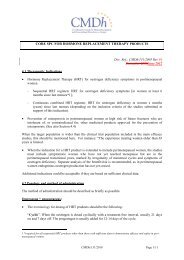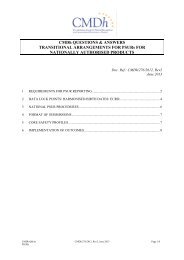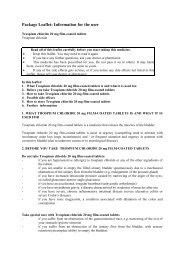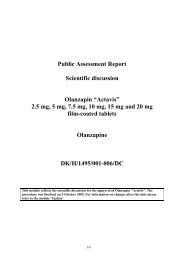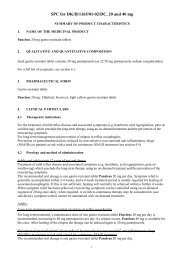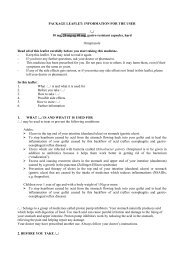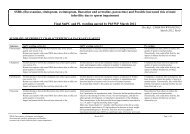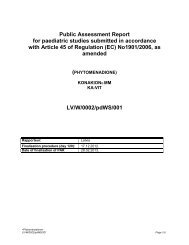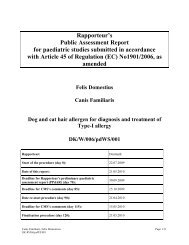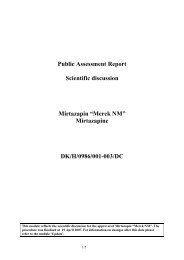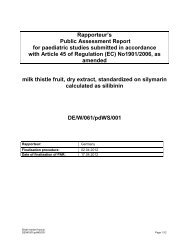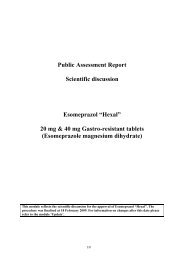Public Assessment Report for paediatric studies submitted in ...
Public Assessment Report for paediatric studies submitted in ...
Public Assessment Report for paediatric studies submitted in ...
You also want an ePaper? Increase the reach of your titles
YUMPU automatically turns print PDFs into web optimized ePapers that Google loves.
Study population/ sample size - children with a cl<strong>in</strong>ical history of reversible airway obstruction<br />
(RAO), stratified <strong>in</strong>to 2 age groups: 6 years or less - 74 children (31%) and 7 years or greater and less than<br />
17 years- 163 (69%).<br />
Treatments - 120 patients received salbutamol CR 4 mg and 117 patients received Salbutamol<br />
standard tablets 2mg. Treatment allocation was randomized <strong>in</strong> balanced blocks with<strong>in</strong> each of these age<br />
groups. Patients were entered <strong>in</strong>to a 2-week pre trial run-<strong>in</strong> period and thereafter randomly allocated to<br />
receive one of the treatment regimens <strong>for</strong> a period of six weeks.<br />
- Group A: Controlled release salbutamol tablets (4 mg salbutamol controlled tablet twice daily<br />
plus one placebo standard 2 mg tablet four times daily)<br />
- Group B: Standard Salbutamol tablets (one placebo controlled tablet twice daily plus one<br />
standard 2 mg salbutamol tablet four times daily)<br />
Endpo<strong>in</strong>ts - primary endpo<strong>in</strong>ts:<br />
- peak expiratory flow rate (PEER), <strong>for</strong>ced expiratory volume <strong>in</strong> one second (FEV1) and <strong>for</strong>ced<br />
vital capacity (FVC) were made <strong>in</strong> those children who were able to per<strong>for</strong>m the spirometry tests reliably.<br />
- second endpo<strong>in</strong>ts - vital capacity (VC) and mid expiratory flow rate (FEV50) were<br />
additional optional assessments.<br />
Statistical methods<br />
For respiratory function measurements was applied the standard statistics methods <strong>for</strong><br />
evaluation the means values (student’s, t distributions). Cl<strong>in</strong>ic lung function measurements were analysed<br />
us<strong>in</strong>g regression analysis adjust<strong>in</strong>g <strong>for</strong> the pre-treatment value and centre.<br />
The mean of the symptom scores <strong>for</strong> each treatment group were compared follow<strong>in</strong>g subtraction<br />
of the basel<strong>in</strong>e values, us<strong>in</strong>g the non-parametric Mann-Whitney test. The proportion of days with no<br />
symptoms was trans<strong>for</strong>med us<strong>in</strong>g the arc-s<strong>in</strong> trans<strong>for</strong>mation (Snedcor and Cochran) and the difference<br />
from basel<strong>in</strong>e values were compared <strong>for</strong> each treatment group us<strong>in</strong>g the standard student’s t test<br />
Safety <strong>Assessment</strong> - Adverse events were tabulated <strong>for</strong> the total population as were abnormal<br />
biochemistry measurements. Cl<strong>in</strong>ical relevant changes <strong>in</strong> biochemistry between the start and end of trial<br />
were identified<br />
Results<br />
Efficacy<br />
Basel<strong>in</strong>e lung function and percentage reversibility of the two treatments group at the start of the<br />
study were seen to be similar with<strong>in</strong> each age group <strong>for</strong> the efficacy population. The CR tablets and<br />
standard tablets were similarly efficacious <strong>in</strong> ma<strong>in</strong>ta<strong>in</strong><strong>in</strong>g lung function <strong>in</strong> the 2, 4, 6 week population<br />
(p>0.05).<br />
No cl<strong>in</strong>ically significant differences between the treatments were identified with respect to<br />
effects on lung function parameters (FEV1, FVC, PEFR, FE50, VC) <strong>for</strong> both age groups. In both young<br />
children and the older children compliance was better <strong>in</strong> the salbutamol CR group.<br />
No significant difference was identified between treatment <strong>in</strong> the change of symptoms scores<br />
and symptom free days over the study period. (p>0.05).<br />
For the children of 6 years or less 79% of the parents <strong>in</strong> the salbutamol CR group assessed the<br />
treatment to be effective or very effective as compared to 67% of the parents <strong>in</strong> the standard tablets group.<br />
For the children of 7 years and over 75% of the parents <strong>in</strong> the salbutamol CR group assessed the treatment<br />
to be effective or very effective, as compared to 61% of the parents <strong>in</strong> the standard tablet group<br />
Safety<br />
Adverse events were determ<strong>in</strong>ed from the total population receiv<strong>in</strong>g treatment with<strong>in</strong> each age<br />
group.<br />
No difference between the two treatments were identified either <strong>in</strong> total numbers of adverse<br />
events or <strong>in</strong> their severity.<br />
Adverse events are divided <strong>in</strong>to recognized pharmacological effects of salbutamol (tremor,<br />
palpitation, muscle cramps) and non – specific but possibly drug related (headache, hyper-activity and<br />
sleep disturbance) and the rema<strong>in</strong>der which probably not drug related. About 50% of the adverse events<br />
Salbutamol F<strong>in</strong>al <strong>Public</strong> <strong>Assessment</strong> <strong>Report</strong><br />
RO/W/0001/pdWS/001<br />
Page 40/76



